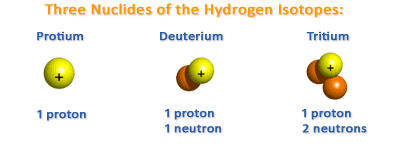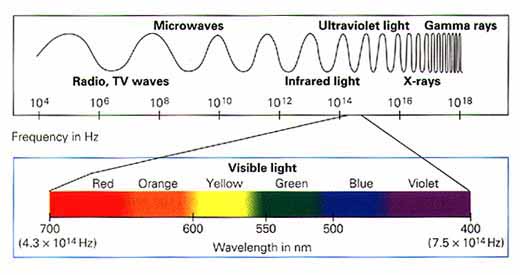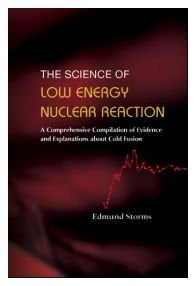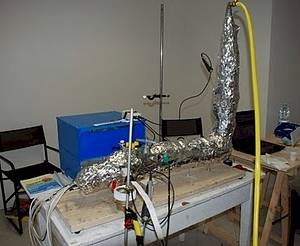[latexpage]
This article organizes information about radiation in three sections.
1 Difference between radioactive materials and radiation.
2 Types of radiation emitted by nuclear processes.
3 No dangerous radiation in cold fusion.
1 Difference between radioactive materials and radiation.
Today’s nuclear fission reactors are more than a poor choice for a primary energy source because of the growing risk of contamination by radioactive materials, which can emit harmful radiation. Humans are not ready to take the responsibility for disaster that could last for geological time, when the amount, and type, of radioactive fuel used in these reactors has the potential to create dead zones for hundreds, if not tens-of-thousands of years.
Why go down this path when there exists an alternative ultra-clean nuclear power? Low-energy nuclear reactions LENR, or cold fusion, is nuclear power from hydrogen, the most common element in the universe, with oceans of it here on Earth. Cold fusion does not use radioactive fuel. Cold fusion does not create harmful radioactive waste. The nuclear reaction occurs inside a tiny piece of metal, like palladium or nickel, in a small device that sits on your tabletop.
Radiation is all around us, everyday, and some radiation of certain kinds can be good and healthy, while other radiation, or too much of the good kind, is bad. For instance, too much solar radiation can cause burns that lead to skin cancers later in life, while too little causes a vitamin D deficiency.
And all radiation is not alike. Of the sunlight reaching Earth’s surface, the ultra-violet portion can burn the skin while the radio-wave portion appears to have left life at the surface unaffected. Both sunlight and X-rays are forms of radiation that are created by nuclear and atomic reactions. But some materials spontaneously and naturally emit radiation, and they are called radioactive. Here is a nice chart about the radiation around us and dosage.
Radioactive materials contain particles of atomic elements that are unstable, and decay, emitting electromagnetic radiation, or photons, as well as other particles, which may themselves also be radioactive.
Radiation describes the particles and photons emitted by a radioactive material.

While hydrogen $^{1}H$ and deuterium $^{2}H$ both are found naturally on Earth in abundance, tritium is not, for tritium is unstable, and decays with a half-life of about 12 years, meaning there is only half as much material left as there was 12 years earlier. This decay characterizes radioactivity.
Tritium is an example of a radioactive particle. During radioactive decay for tritium, the nucleus of the tritium atom, called a triton, which has one proton and two neutrons, turns into a Helium-3 atom $^{3}He$, an electron, and another tiny energetic particle called a neutrino, all releasing 18.6 keV of energy.[1]
A triton has one proton and two neutrons. The nucleus of the $^{3}He$ has two protons and one neutron. During radioactive decay of the tritium atom, one of the original neutrons in the triton turned into a proton, along with creating an electron and a neutrino in a process called Beta decay, written β−.

Electrons are usually thought of as carrying electrical current to power our appliances. But a large charge of current can be deadly. A beta particle (electron) will fly out with a varying kinetic energy averaging 5.7 keV. [1] This particle is incapable of penetrating the skin. External sources of beta decay from tritium will not harm the body.
But if a radioactive particle is inhaled or ingested, then beta-decay can cause damage to the cells of the body. The radioactive particle will eventually decay and emit a Beta particle that can then collide with internal tissue, perhaps ionizing the atoms in cells. If the Beta particle hits a DNA molecule, lasting genetic consequences can ensue.

There is little naturally occurring tritium here on Earth because most of it has decayed away. Tritium is manufactured for commercial use and for use in hot fusion reactors selling for \$30,000US a gram.[1]
Tritium is not used in cold fusion research. Cold fusion cells use hydrogen $^{1}H$ and deuterium $^{2}H$, both cheap, plentiful, and evenly distributed around the earth in sea-water. No radioactive fuel is used in the cold fusion process.
2 Types of radiation emitted by nuclear processes.
In the conventional nuclear reactions of fission and hot fusion, the main types of radiation seen are particles like alpha particles, beta particles, and electromagnetic radiation such as gamma rays or x-rays. The three main types of radiation are named in the order that they were discovered and after the first three letters of the Greek alphabet. Conventional nuclear fission which relies on a chain-reaction, also produces neutrons.
Alpha particles are helium nuclei. That is to say that alpha particles are the nucleus of helium atoms, consisting of two protons and two neutrons $^{4}He$. Alpha particles are emitted by the natural radioactivity of the heavier elements and their isotopes. Alpha particles are larger clusters of nucleons and generally have low energy that a piece of paper will shield against alpha particles.
Beta particles β−, are electrons that are emitted during beta decay. Beta-emitting isotopes can have a half-life as long as $10^{16}$ years or as short as milliseconds. Beta particles can also be positively- charged positrons denoted β+. Beta particles can be stopped by ”a few millimeters of aluminum”.[2]
Gamma radiation is made up of light, or high-energy photons, that have an extremely small wavelength. They are similar to x-rays, with gamma rays carrying more energy. ”X-rays result when electrons return to a lower energy by emitting electromagnetic radiation and gamma radiation result when particles in the nucleus return to a lower energy.” [1,153]

Both gamma radiation and x-rays will penetrate the body easily and they can be harmful to living tissue. Only shielding made of lead will stop gamma radiation.
Some nuclear reactions can also create neutrons. Neutrons can be dangerous as they can penetrate the body, ionizing cells and creating genetic damage.
3 No dangerous radiation in cold fusion.
While no source of energy is 100% clean, cold fusion ranks cleaner over oil, gas, coal, today’s nuclear fission, hot fusion, solar and wind. Solar and wind are renewable sources, but the materials and manufacturing of solar panels and wind turbines given their energy density don’t compare to cold fusion.
First of all, LENR is a process of that does not involve today’s nuclear fission power designs, so there is no chain-reaction. A cold fusion cell will not ”runaway” like critical masses and fission bombs. Cold fusion energy devices will turn on and off when you want them to.
 Edmund Storms, a nuclear scientist who has researched cold fusion for over two decades wrote a survey of the field called The Science of Low Energy Nuclear Reaction. Published in 2007, it is a technical summary of results for a scientific reader. In it, there are clear statements about the lack of radiation from cold fusion cells.
Edmund Storms, a nuclear scientist who has researched cold fusion for over two decades wrote a survey of the field called The Science of Low Energy Nuclear Reaction. Published in 2007, it is a technical summary of results for a scientific reader. In it, there are clear statements about the lack of radiation from cold fusion cells.
This table from Storms’ Science provides the general experimental results regarding radiation from LENR experiments.
Table 14 Expected but missing behavior. [1,176]
1. Gamma emission is rare.
2. Neutron emission is rare.
3. Alpha emission rate is not consistent with accumulated helium.
4. X-rays expected when a significant alpha flux is absorbed are missing.
5. The second nuclear product resulting from transformation is frequently missing.
A listing of the reported studies showing radiation detected in LENR experiments can be found in Table 11 of Storms’ Science[1]. Each entry is listed with radiation type and strength, along with the kind of cell that produced it. He writes:
”Fortunately none of this radiation is a health hazard nor is it easy to detect outside of the apparatus, which makes the process sate to study and safe as an eventual source of energy.” [1,105]
Quite simply, the type and quantity of radiation seen in today’s nuclear power does not show up LENR.
Cold fusion cells do not behave at all like conventional theories of nuclear reactions dictate. The fact that dangerous levels are missing from this reaction was in part responsible for many scientists dismissal of this as a nuclear effect. To quote Nobel laureate Julian Schwinger ”The circumstances of cold fusion are not those of hot fusion.”
Infinite Energy magazine published an FAQ containing this question: Why doesn’t cold fusion produce dangerous ionizing radiation and neutrons?
“Nobody knows for certain why the primary signature of cold fusion is excess heat, not deadly radiation. Nevertheless, many LENR theorists have put forth very intriguing proposals for the mechanism of these reactions. There are, in fact, many dozens of competing theories smaller number of which are very well fleshed out. The exact nature of the LENR reactions is one of the many unsolved scientific mysteries surrounding them. Some scientists think that because the effect does not produce intense radiation, it cannot be a nuclear process. Others say the energy is produced, but then somehow absorbed by the metal lattice either as high frequency vibrations, or through coherent processes in which many delocalized vibrations are involved.” [7]
LENR devices do not have any appreciable radiation from alpha particles, beta particles, high- energy neutrons, and there is no danger of a runaway chain reaction. What about the x-rays and gamma radiation, those high-energy photons that could pose a risk to biological life? Storms writes:
”Most X-radiation will be absorbed by the apparatus, thereby making its detection unlikely.”[1,153]
Andrea Rossi’s LENR-powered hot-water boiler, the Energy Catalyzer ECat, is expected to be the first commercial application of this new energy science and uses micro-sized nickel particles infused with hydrogen gas to initiate power production. The ECat is currently being tested and evaluated at the University of Bologna in Bologna, Italy. This device will be commercially implemented in a factory in Athens, Greece, where it will undergo further tests on its safety in an industrial setting.[3]

For wide-spread use of cold fusion technology, these devices must be safe for the public. This was noted by Jed Rothwell in his Cold Fusion and the Future.
“Some people fear there may be a hidden, long term threat to the health of people who work in close proximity to cold fusion reactors. So far, nobody has detected dangerous levels of x-rays or other emissions from a cold fusion cell. The autoradiographs prove that cold fusion does produce low levels of radioactivity, but the levels are so low that scientists have difficulty detecting them with sensitive instruments. Compared to the radiation from televisions and the natural background of radiation from space, radon and other sources, cold fusion radiation seems likely to remain so low as to be nearly undetectable. Still, cold fusion might conceivably produce some unknown form of radiation or some other deleterious effect. We will have to make sure this is not the case, by exposing rats and other laboratory animals to unshielded cold fusion reactors, and by carefully monitoring the health of the first group of people who work with the reactors every day.“[4]
On Rossi’s device, ”about 50 kilograms of lead shielding, about 2 centimeters thick, protects against any gamma radiation.”[6] During an open Q&A after the NyTeknik interview, the question of gamma radiation from the ECat was posed to inventor Rossi by a member of the public, Goran Ericsson. ”If no gammas are observed, what is the reason to believe nuclear reactions are involved?”
“Andrea Rossi: We observed gammas under the 300 keV range. We did not find, so far, the couple at 180 degrees at 511 keV, and the research we are continuing with the University of Bologna is aimed also to better probe the specter of the gamma produced. It will take some month of research, after which we will able to better understand the theory at the root of the thermal effect.
We have to calculate also the recoil energy, integrated with the kinetic energy we produce. We want to correlate the thermal effect with the gamma specter we will define. We also are continuing to analyze the atomic and isotopical transmutation, to correlate it to the gamma and to the thermal effect. I want to know if Cu-59, 60, 61, 62 decay by electron capture, instead of beta plus emission; if so a very interesting consideration can be derived.
This a very difficult research we are investing on (my money). And, at last, if we will not find high energy gamma and 511 keV couples, well, we will have to think about a new rule. It would not be the first time: they have digged a big hole, there in Geneva, to understand things, and they are finding things by the classic physics could not happen, particle that by the classic physics could not exist. But those things, evidently, are not good Physics students, so they insist to exist. Just read the ”Nuclear Models” of Greiner Maruhn to get a taste of this.“[5]
Speculating on what could happen if Rossi’s device broke, Hank Mills of Pure Energy Systems news wrote:
“There could potentially be a very brief spike of radioactivity for a moment if the vessel cracked or failed, but the venting of the hydrogen gas would immediately end the nuclear reactions taking place and any production of radioactivity.” [4]
An additional batch of questions from Ny Teknik’s readers was answered by Mr. Rossi, some of which addressed the question of radiation from beta decay and radioactivity.
“Peter Ekstrm: In the fusion of a proton with Ni-58 a substantial activity of Cu-59 is formed. Cu-59 decays with a half-life of 82 seconds by beta+ decay. In the Focardi and Rossi article it is stated that: ”No radioactivity has been found also in the Nickel residual from the process”. Considering the very high activity of Cu-59 that is produced, it is surprising that no activity is detected. Even ten half-lives after the end of a run the activity should be of the order of 1013 Bq, which is not only easily measurable (with a detector far away from the source) but also deadly for everybody present in the room! (Could you explain?)
Rossi: No radioactivity has been found in the residual metals, it is true, but the day after the stop of the operation. In any case you are right, if 59-Cu is formed from 58-Ni we should have the couples of 511 keV at 180 and we never found them, while we found keV in the range of 100-300 keV. I think no 59Cu is produced, I suppose only stable Cu is produced from the transmutation of the isotopes 62Ni and 64Ni. I desume this from what we find after the operations. Your observation is correct.”
Cold fusion technology is just beginning to emerge from a science into a technology. Much is still unknown about the science, and further testing will be taken over the next several years to ensure the safety of this technology. To date, cold fusion devices have not produced any appreciable dangerous radiation like that of today’s nuclear fission reactors. Scientists who have worked in this field for the past two decades are healthy and safe.
More importantly, LENR reactions produce energy that is cleaner than any source of power used today. Whether it’s hydrocarbons like oil, gas, or coal, or renewable technologies such a solar and wind, the power of cold fusion lies in its incredible energy density, a nuclear power from hydrogen and greener than today’s nuclear fission power plants.
References:
1 The Science of Low Energy Nuclear Reaction by Edmund Storms World Scientific 2007
2 http://en.wikipedia.org/wiki/Beta_particle
3 http://en.wikipedia.org/wiki/Tritium
4 Jed Rothwell: Cold Fusion and the Future Part 1 – Revolutionary Technology http://www. infinite-energy.com/iemagazine/issue12/coldfusion5.html
5 Welcome Worry-Free Nuclear Power: Rossi’s Energy Catalyzer by Hank Mills Pure Energy Systems news
6 36 more ques- tions asked by the readers of NyTeknik http://www.nyteknik.se/nyheter/energi_miljo/energi/article3126617.ece
7 Why doesn’t cold fusion produce dangerous ionizing radiation and neutrons? Infinite- energy FAQ http://www.infinite-energy.com/resources/faq. html#Q21
8 UC Davis Training in Radiation http://www.research.ucdavis.edu/home.cfm?id=mrt,13,1137,1139

Heat production detected radiation and detected fusion products suggest that some kind of nuclear reaction or fusion takes place but the reactions do not show the amount of radiation and the ratios of products that known hot fusion reactions do. ……Output of neutrons n tritium T protons p and gamma radiation has been reported by cold fusion but not in the amount predicted by standard understanding.
THERE ISN’T “flak gamma emission” at all;
the CF is the same of : sonofusion or supercavitation reaction!! look at shkval torpedo!
http://www.facebook.com/note.php?note_id=10150177066770079